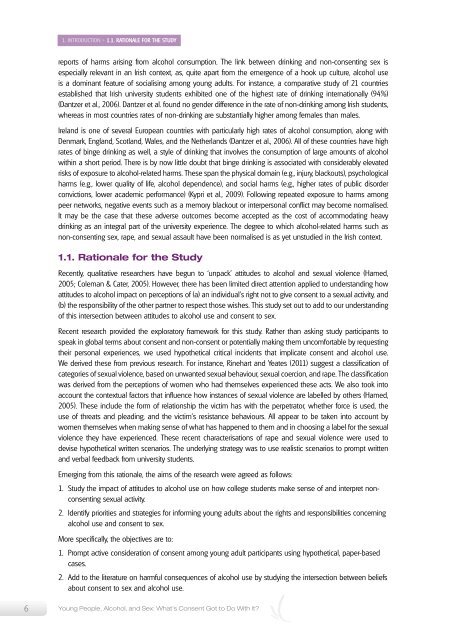Whats-Consent-Full-A41
Whats-Consent-Full-A41
Whats-Consent-Full-A41
Create successful ePaper yourself
Turn your PDF publications into a flip-book with our unique Google optimized e-Paper software.
1. Introduction > 1.1. Rationale for the Studyreports of harms arising from alcohol consumption. The link between drinking and non-consenting sex isespecially relevant in an Irish context, as, quite apart from the emergence of a hook up culture, alcohol useis a dominant feature of socialising among young adults. For instance, a comparative study of 21 countriesestablished that Irish university students exhibited one of the highest rate of drinking internationally (94%)(Dantzer et al., 2006). Dantzer et al. found no gender difference in the rate of non-drinking among Irish students,whereas in most countries rates of non-drinking are substantially higher among females than males.Ireland is one of several European countries with particularly high rates of alcohol consumption, along withDenmark, England, Scotland, Wales, and the Netherlands (Dantzer et al., 2006). All of these countries have highrates of binge drinking as well, a style of drinking that involves the consumption of large amounts of alcoholwithin a short period. There is by now little doubt that binge drinking is associated with considerably elevatedrisks of exposure to alcohol-related harms. These span the physical domain (e.g., injury, blackouts), psychologicalharms (e.g., lower quality of life, alcohol dependence), and social harms (e.g., higher rates of public disorderconvictions, lower academic performance) (Kypri et al., 2009). Following repeated exposure to harms amongpeer networks, negative events such as a memory blackout or interpersonal conflict may become normalised.It may be the case that these adverse outcomes become accepted as the cost of accommodating heavydrinking as an integral part of the university experience. The degree to which alcohol-related harms such asnon-consenting sex, rape, and sexual assault have been normalised is as yet unstudied in the Irish context.1.1. Rationale for the StudyRecently, qualitative researchers have begun to ‘unpack’ attitudes to alcohol and sexual violence (Hamed,2005; Coleman & Cater, 2005). However, there has been limited direct attention applied to understanding howattitudes to alcohol impact on perceptions of (a) an individual’s right not to give consent to a sexual activity, and(b) the responsibility of the other partner to respect those wishes. This study set out to add to our understandingof this intersection between attitudes to alcohol use and consent to sex.Recent research provided the exploratory framework for this study. Rather than asking study participants tospeak in global terms about consent and non-consent or potentially making them uncomfortable by requestingtheir personal experiences, we used hypothetical critical incidents that implicate consent and alcohol use.We derived these from previous research. For instance, Rinehart and Yeates (2011) suggest a classification ofcategories of sexual violence, based on unwanted sexual behaviour, sexual coercion, and rape. The classificationwas derived from the perceptions of women who had themselves experienced these acts. We also took intoaccount the contextual factors that influence how instances of sexual violence are labelled by others (Hamed,2005). These include the form of relationship the victim has with the perpetrator, whether force is used, theuse of threats and pleading, and the victim’s resistance behaviours. All appear to be taken into account bywomen themselves when making sense of what has happened to them and in choosing a label for the sexualviolence they have experienced. These recent characterisations of rape and sexual violence were used todevise hypothetical written scenarios. The underlying strategy was to use realistic scenarios to prompt writtenand verbal feedback from university students.Emerging from this rationale, the aims of the research were agreed as follows:1. Study the impact of attitudes to alcohol use on how college students make sense of and interpret nonconsentingsexual activity.2. Identify priorities and strategies for informing young adults about the rights and responsibilities concerningalcohol use and consent to sex.More specifically, the objectives are to:1. Prompt active consideration of consent among young adult participants using hypothetical, paper-basedcases.2. Add to the literature on harmful consequences of alcohol use by studying the intersection between beliefsabout consent to sex and alcohol use.6 Young People, Alcohol, and Sex: What’s <strong>Consent</strong> Got to Do With It?


